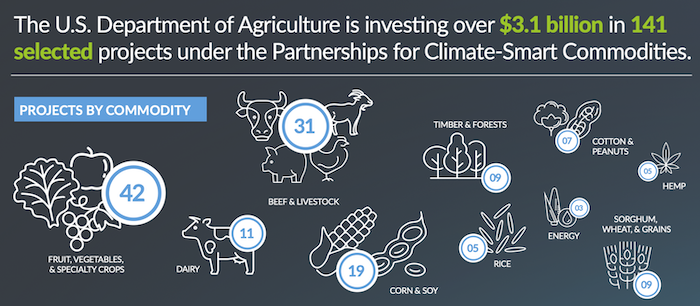The USDA’s Partnership for Climate-Smart Commodities program represents an investment of over $3.1 billion into US agriculture. The statistics for the program huge: USDA selected 141 proposals from corporations, non-profits, and universities to study ways to increase climate-smart production practices for US farmers and livestock producers. USDA estimates that over the next 5 years more than 60 million tons of carbon dioxide will be sequestered as a result of the program. You can learn more about specific programs on the USDA’s dashboard for Climate-Smart Commodities.
But what I am most interested in is USDA’s collection of production data from US farms and fields through Climate-Smart Commodities.
 SOURCE: USDA INFOGRAPHIC ON CLIMATE-SMART COMMODITIES
SOURCE: USDA INFOGRAPHIC ON CLIMATE-SMART COMMODITIESUSDA is no stranger to data collection. The National Agriculture Statistic Service (NASS) has collected farm census data for decades. Similarly, Farm Service Agency (FSA) and the Risk Management Agency (RMA) have long collected data about US farmers and ranchers for farm programs and crop insurance purposes. This data has remained siloed as USDA and is general in nature. Data collection through Climate-Smart Commodities is going to be much more granular.
Any grant recipient who receives funds from USDA through the Climate-Smart Commodities program is required to submit data to USDA regarding use of the grant. USDA has published “Data Dictionary” that explains the data collection that is required. In general, there are four levels of data collection from the most general to the most specific:
-
Project Level: This is information about the project at the aggregate level.
-
Partner Level: This is information about the activities of grant awardee within a project.
-
Producer Level: This is information about the farms selected by the grant awardee who are enrolled in a specific award-funded project.
-
Field Level: This is information from specific fields where a project is administered.
The Data Dictionary further defines the subcategories of data that needs to be collected by grant awardees (and sub-awardees) at each level. For example, at the Field Level, the grant recipient should collect data with the following: (1) Tract ID; (2) Field ID; (3) State; (4) County; (5) Total Field Area; (6) Commodity category; (7) Commodity type; (8) Baseline yield; (9) Field land use; (10) Field irrigated; (11) Field tillage; (12) Practice past extent ‐ farm; etc. (These are not an exhaustive list; consult the Data Dictionary for more).
Collection of data raises some concerns to be addressed by the grant awardees. First, grant awardees must inform their enrolled producers of the data collection requirements from UDSA. I recommend a simple, transparent data collection agreements created by the grant recipient to be shared with producers. Producers should have the ability to consent to data collection that will be required for USDA reporting at the time they enroll.
Second, grant recipients should make sure that their sub-awardees—the companies they are using to complete the grant-funded project—are aware of the USDA data collection requirements. These sub-awardees should contractually agree to abide by the data collection policy established by the primary grant recipient.
Finally, there will be farmer concerns about how USDA might use ag data that it collects through Climate-Smart Commodities. USDA states in its Data Dictionary that data submitted is protected by federal law, 7 USC 8791. This statute prohibits USDA from releasing producer information that identifies the agricultural operation specifically. Release of aggregated statistics is allowed if the disclosure excludes individual owner, operator, or producer names and specific data gathering sites. In sum, general aggregated statistics might be released but individual producer data will not be.
It is going to be interesting to see how this all comes together. There is going to be an enormous amount of field-level ag data collected about “climate-smart” agriculture. We should learn a lot about what truly works and what doesn’t when sequestering carbon with agriculture. For now, while we are at the front end of this process, lets focus on making sure we get the data collection contracts right.






Post a comment
Report Abusive Comment